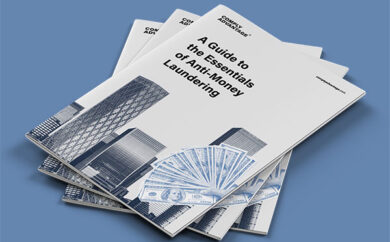

In 2023, global financial crime generated over $3 trillion, with significant amounts stemming from drug trafficking, human trafficking, and various forms of fraud. With these threats growing in complexity, it’s more important than ever for firms to consider adapting their compliance strategies to stay ahead of emerging risks.
During a webinar run by ComplyAdvantage’s Regulatory Affairs team, industry experts Sepideh Rowland from FTI Consulting and Leanda Mark-Ihama from Thistle Initiatives shared valuable tips on combating these challenges.
This article summarizes their insights into seven practical strategies for bolstering compliance efforts and building a robust anti-money laundering (AML) framework in 2024 and beyond.
1. Embrace unified compliance approaches
Global efforts to combat financial crime are increasingly moving toward standardized frameworks – an essential in today’s interconnected world. The European Union’s AML Single Rulebook and the US Corporate Transparency Act (CTA) are leading examples of this. The AML Single Rulebook aims to coordinate regulations across EU countries, making it easier to manage cross-border operations. Meanwhile, the CTA focuses on increasing transparency in corporate ownership, tackling the opaque structures that have often been found to facilitate financial crime.
By aligning compliance strategies with these international standards, firms can simplify their operations, efficiently manage multiple regulatory requirements, and mitigate cross-border risks.
2. Address regulatory overlaps and expansions
As regulatory requirements continue to change worldwide, an overlap between different aspects of financial crime compliance is increasing – such as anti-fraud measures and AML. The UK’s Economic Crime Plan acknowledges this significant crossover between money laundering activities and fraudulent schemes by emphasizing the growing importance of integrating fraud prevention with AML frameworks,
To effectively address these overlaps, financial institutions (FIs) should take a holistic view of their financial crime frameworks. This may involve aligning AML and anti-fraud strategies and integrating them with related areas, such as cybersecurity and data protection. By doing so, FIs can ensure interconnected risks are effectively managed, and there are no gaps in their compliance programs.
From a UK perspective, there is a significant focus on integrating fraud prevention with AML requirements. A holistic view of your financial crime framework is essential, given the crossover between money laundering and fraud.
Leanda Mark-Ihama, Senior Manager, Thistle Initiatives
Furthermore, an integrated framework can enable enhanced communication and collaboration between departments, such as compliance, legal, and IT, ensuring comprehensive coverage of all aspects of financial crime risk.
3. Stay updated on sanctions and regulatory changes
To stay ahead of changing sanctions lists and increasingly stringent regulatory expectaions, it is crucial for FIs to implement compliance systems that can quickly respond to these changes.
One effective strategy is to establish a dedicated team or appoint a compliance officer responsible for monitoring and responding to updates in real-time. These staff members should have access to reliable sources of information – such as government publications, industry news, and compliance networks – to ensure they are always informed of the latest developments. Regular updates to compliance procedures and monitoring tools are also essential. This may involve automating some aspects of the compliance program – such as sanctions screening – to ensure the FI is always aligned with the latest requirements.

Build your AML roadmap
Watch our on-demand webinar to explore the financial crime trends and regulations that will shape the coming months, and map out the actions your team can take now to prepare effectively.
Watch on-demand4. Implement enhanced screening for crowdfunding transactions
The rise in crowdfunding, particularly during the pandemic, opened new avenues for fundraising. However, the relative anonymity and ease of access offered by crowdfunding platforms make them attractive targets for illicit actors seeking to raise funds for terrorist activities.
To mitigate these risks, FIs must enhance their due diligence practices, particularly when dealing with crowdfunding campaigns. This includes thoroughly vetting the legitimacy of charitable organizations and individuals behind these campaigns and ensuring funds are used for their intended purposes.
During the pandemic, crowdfunding saw exponential increases in engagement, and with that came the risk of misuse. Financial institutions must ensure robust due diligence, understanding where funds come from and how they are used, especially in relation to potential terrorist financing.
Sepideh Rowland, Senior Managing Director, FTI Consulting & Co-Chair ACAMS US Capital Chapter
One approach is to implement enhanced screening procedures for crowdfunding transactions, similar to those used for high-risk customers. This might involve more rigorous checks on the sources of funds (SoF) and closer monitoring of how funds are distributed and used.
5. Optimize data sharing and technology use
New data-sharing mechanisms and advanced technologies are reshaping the way FIs manage financial crime risks. When fine-tuned to a firm’s particular needs, these tools – such as artificial intelligence and machine learning – can enhance the accuracy of risk assessments and improve the overall effectiveness of compliance programs.
For example, AI-powered analytics can identify suspicious patterns in transaction data that might be missed by traditional methods. Similarly, blockchain technology can enhance transparency and traceability in financial transactions, making it harder for criminals to conceal illicit activities.
However, to fully leverage these technologies, organizations must be prepared to invest in the necessary infrastructure and talent. This might involve upgrading existing systems, implementing new software solutions, or hiring experts with specialized knowledge in data science and cybersecurity.
6. Balance automation with ethical compliance
While automation offers significant benefits in terms of efficiency and cost savings, it is essential to balance these advantages with ethical considerations. As organizations increasingly rely on AI to streamline compliance processes, the potential for unintended consequences, such as bias in decision-making, becomes increasingly likely.
These technologies have been with us for a very long time, but their application in a financial crime context is growing more sophisticated. As compliance leaders, we need to make sure our models aren’t introducing unnecessary bias, which could impact our customers.
Andrew Davies, Global Head of Regulatory Affairs, ComplyAdvantage
To mitigate these risks, organizations must ensure AI systems are transparent and that their decision-making processes can be explained and justified. This might involve conducting regular audits of AI models to check for bias and implementing safeguards to prevent discriminatory outcomes.
7. Build a case for technological investments
Before adopting new technology, it is important to evaluate existing processes and resources to identify gaps and areas for improvement. This might involve conducting a comprehensive assessment of current systems and workflows to determine where technology can add the most value.
However, engaging stakeholders across different departments is also crucial for securing buy-in and support for technological investments.
It always surprises me when we talk to people in senior financial crime roles who don’t regularly talk to their chief product owners or their chief data officers. It takes a whole village to raise a child, and the same is true about introducing a new piece of technology to your infrastructure.
Iain Armstrong, Regulatory Affairs Practice Lead, ComplyAdvantage
By clearly communicating the benefits of technology, not only in terms of compliance but also in terms of operational efficiency and commercial gains, organizations can build a compelling case for why the investment is necessary.
See how ComplyAdvantage can help you fine-tune your financial crime risk management processes
000s of organizations are already using ComplyAdvantage. Learn how to streamline compliance and mitigate risk with industry-leading solutions.
Get a demoOriginally published 03 September 2024, updated 11 February 2025
Disclaimer: This is for general information only. The information presented does not constitute legal advice. ComplyAdvantage accepts no responsibility for any information contained herein and disclaims and excludes any liability in respect of the contents or for action taken based on this information.
Copyright © 2026 IVXS UK Limited (trading as ComplyAdvantage).
